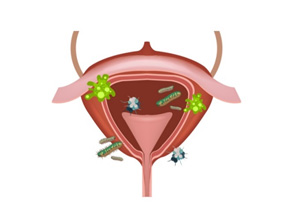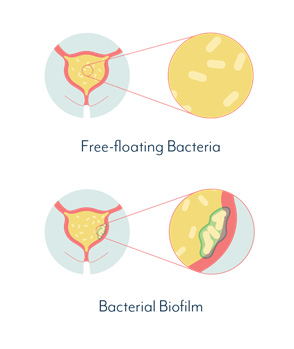RECURRENT UTIs (aka Urinary tract infections or Bladder Infections)
DEFINITION of Recurrent UTIs (urinary tract infections)
Recurrent UTIs are defined as:
- 3 or more bladder infections in 1 year
- 2 or more bladder infections in 6 months

CAUSES of Recurrent UTIs
- Biggest risk factor is intimacy. Sexual intercourse pushes the bacteria from the outside skin and vulvar area INTO the bladder which triggers the bladder infection.
- Other risk factors include soaking in any type of water like a pool or Jacuzzi.
- Immunocompromised with weakened immune system.
- Sometimes, there is NO known cause for the recurrent UTIs.
SIMPLE UTI versus RECURRENT UTI
- SIMPLE UTI is when the bacteria are “free-floating” in the urine itself.
- RECURRENT UTIs is when the bacteria invade the INNER lining of the bladder wall. So, a full course of antibiotics for 5-7 days may clear 80-90% of the bacteria, but there are ALWAYS a 10-20% residual bacteria still PERSISTENT within the bladder lining. These RESIDUAL bacteria will eventually lead to recurrent UTIs in the future.

FIVE different management options for Recurrent UTIs
- 1st line is conservative management. Do nothing.
- 2nd line is a trial of D-Mannose or Cranberry tablets or a combination of both.
- 3rd line is a low dose antibiotic ONLY after intimacy at bedtime.
- 4th line is a low dose antibiotic NIGHTLY for the next 3 months.
- 5th line is the MAXIMUM prevention plan using a nightly low dose antibiotic plus Hiprex BID x 3 months EARLY detection of future UTIs.
For patients who are unaware or uncertain if they have a bladder infection or just an Interstitial Cystitis Flare
- The first line of treatment is to perform HOME URINE DIPSTICKS. The patient dip her own urine at home and if the urine dipstick is POSITIVE for either leukocytes or nitrites, then the patient can start antibiotic immediately or check a urine culture, which usually takes about 2 days to get the final results.
- The second line would be to check a urine culture at the nearest lab or physician’s office. Wait for the culture results prior to starting treatment.